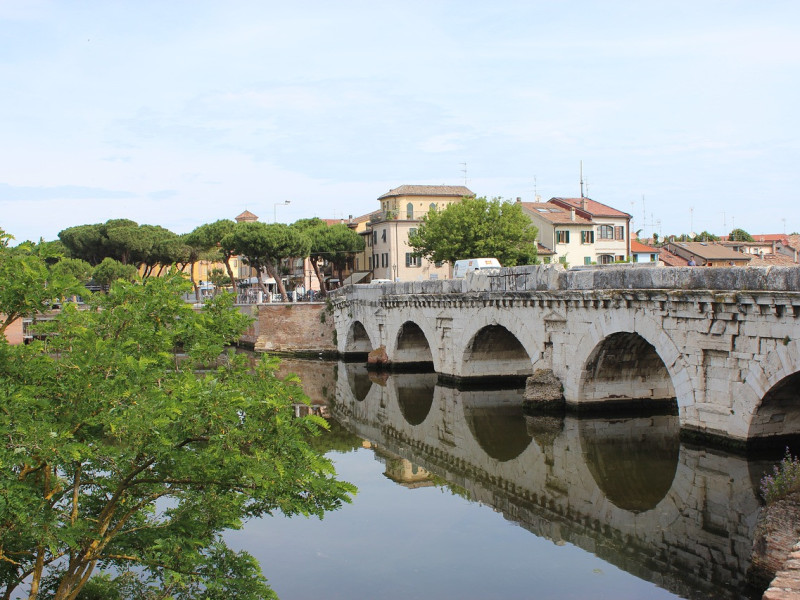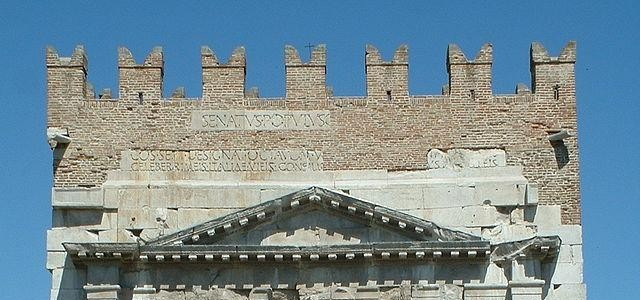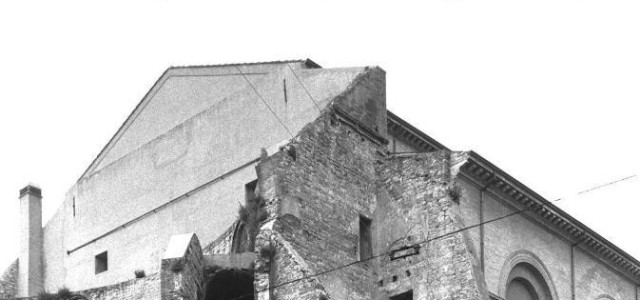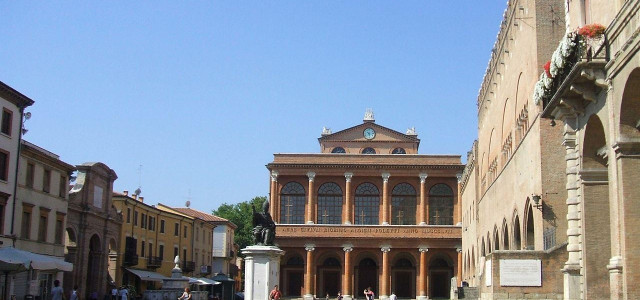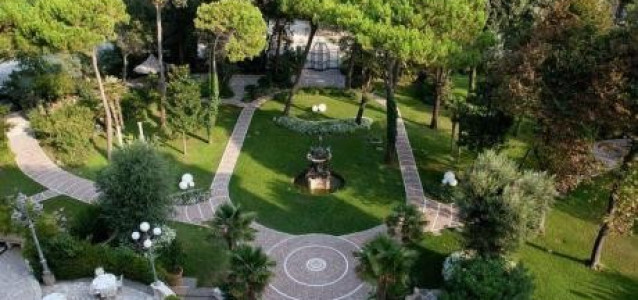Rimini
Rimini (Italian pronunciation: [ˈriːmini] ( ); Latin: Ariminum) is a city of 146,606 inhabitants in the Emilia-Romagna region of Italy, and capital city of the Province of Rimini. It is located on the Adriatic Sea, on the coast between the rivers Marecchia (the ancient Ariminus) and Ausa (ancient Aprusa). It is one of the most famous seaside resorts in Europe, thanks to its 15 kilometres (9 miles) long sandy beach, over 1,000 hotels and thousands of bars, restaurants and discos. The first bathing establishment opened in 1843. An art city with ancient Roman and Renaissance monuments, Rimini is the hometown of the famous film director Federico Fellini as well. Founded by the Romans in 268 BC, throughout their period of rule Rimini was a key communications link between the north and south of the peninsula, and on its soil Roman emperors erected monuments like the Arch of Augustus and the Tiberius Bridge, while during the Renaissance, the city benefited from the court of the House of Malatesta, which hosted artists like Leonardo and produced works such as the Malatesta Temple. In the 19th century, Rimini was one of the most active cities in the revolutionary front, hosting many of the movements aimed at the unification of Italy. In the course of World War II the city was the scene of clashes and bombings, but also of a fierce partisan resistance that earned it the honor of a gold medal for civic valor. Finally, in recent years it has become one of the most important sites for trade fairs and conferences in Italy. The total approximate population of Rimini Urban Area is 225,000 and the provincial population is 330,000. History Ancient history In 268 BC at the mouth of the Ariminus river, in an area that had previously been inhabited by the Etruscans, the Umbrians, the Greeks and the Gauls, the Romans founded the colony of Ariminum, probably from the name of a nearby river, Ariminus (today, Marecchia). Previously the area had been Gaulish, from the 6th century BC, to that group's final defeat in 283 BC by the Umbri, in whose possession it remained until 263 BC when it became a Latin colony very helpful to the Romans during the late Gallic wars. The city was involved in the civil wars but remained faithful to the popular party and to its leaders, firstly Marius, and then Caesar. After crossing the Rubicon, the latter made his legendary appeal to the legions in the Forum of Rimini. Ariminum was seen as a bastion against invaders from Gaul and also as a springboard for conquering the Padana plain. As the terminus of the Via Flaminia, which ended here in the surviving prestigious Arch of Augustus (erected 27 BC), Rimini was a road junction connecting central Italy and northern Italy by the Via Aemilia that led to Piacenza and the Via Popilia that extended northwards; it also opened up trade by sea and river. Remains of the amphitheater that could seat 12000 people, and a five-arched bridge of Istrian stone completed by Tiberius (21 AD) are also still visible. Later Galla Placida built the church of San Stefano. Crisis in the Roman world was marked by destruction caused by invasions and wars, but also by the testimony of the palaces of the Imperial officers and the first churches, the symbol of the spread of Christianity that held an important Council in Rimini in 359. Middle Ages When the Ostrogoths conquered Rimini in 493, Odoacer, besieged in Ravenna, had to capitulate. During the Gothic War Rimini was taken and retaken many times. In its vicinity the Byzantine general Narses overthrew (553) the Alamanni. Under the Byzantine rule, it belonged to the Pentapolis, part of the Exarchate of Ravenna. In 728, it was taken with many other cities by the Lombard King Liutprand but returned to the Byzantines about 735. King Pepin gave it to the Holy See, but during the wars of the popes and the Italian cities against the emperors, Rimini sided with the latter. In the thirteenth century, it suffered from the discords of the Gambacari and Ansidei families. The city became a municipality in the fourteenth century and with the arrival of the religious orders, numerous convents and churches were built, providing work for many illustrious artists. In fact, Giotto inspired the 14th-century School of Rimini, which was the expression of original cultural ferment. The Malatesta family emerged from the struggles between municipal factions with Malatesta da Verucchio, who in 1239 was named podestà (feudal lord) of the city. Despite interruptions, his family held authority until 1528. In 1312 he was succeeded by Malatesta II, first signore (lord) of the city and Pandolfo I, the latter's brother, named by Louis the Bavarian imperial vicar in Romagna. Ferrantino, son of Malatesta II (1335), was opposed by his cousin Ramberto and by Cardinal Bertando del Poggetto (1331), legate of John XXII. Malatesta Guastafamiglia (1363) was also lord of Pesaro. He was succeeded by Malatesta Ungaro (1373) and Galeotto, uncle of the former (1385), lord also of Fano (from 1340), Pesaro, and Cesena (1378). His son Carlo, one of the most respected condottieri of the time, enlarged the Riminese possessions and restored the port. Carlo died childless in 1429, and the lordship was divided into three parts, Rimini going to Galeotto Roberto, a Catholic zealot who turned out to be totally inadequate for the role. The Pesarese line of the Malatestas tried, in fact, to take advantage of his weakness and to capture the city, but Sigismondo Pandolfo Malatesta, Carlo's nephew, who was only 14 at the time, intervened to save it. Galeotto retired to a convent, and Sigismondo obtained the rule of Rimini. Sigismondo Pandolfo was the most famous lord of Rimini. In 1433 Emperor Sigismund soujourned in the city and for a while he was the commander-in-chief of the Papal armies. A skilled general, Sigismondo often acted as condottiero for other states to gain money to embellish it (he was also a dilettante poet). He had the famous Tempio Malatestiano rebuilt by Leon Battista Alberti. However, after the rise of Pope Pius II he had to fight constantly for the independence of the city. In 1463 he was forced to submit to Pius II, who left him only Rimini and little more; Roberto Malatesta, his son (1482), under pope Paul II nearly lost his state but under Sixtus IV became the commanding officer of the pontifical army against Ferdinand of Naples. Sigismondo was, however, defeated by Neapolitan forces in the battle of Campomorto (1482). Pandolfo IV, his son (1500), lost Rimini to Cesare Borgia, after whose overthrow it fell to Venice (1503–1509), but it was later retaken by pope Julius II and incorporated into the Papal States. After the death of pope Leo X, Pandolfo returned for several months, and with his son Sigismondo held a rule which looked tyrannous even for the time. Pope Adrian VI expelled him again and gave Rimini to the Duke of Urbino, the pope's vicar in Romagna. In 1527 Sigismondo managed to regain the city, but in the following year the Malatesta dominion died forever. Modern history At the beginning of the 16th century Rimini, now a secondary town of the Papal States, was ruled by an Apostolic Legate. Towards the end of the 16th century, the municipal square (now Piazza Cavour), which had been closed off on a site where the Poletti Theatre was subsequently built, was redesigned. The statue of Pope Paul V has stood in the centre of the square next to the fountain since 1614. In the 16th century, the 'grand square' (now the Piazza Tre Martiri in honor of three civilians hanged by the retreating Nazis at the end of World War II), which was where markets and tournaments were held, underwent various changes. A small temple dedicated to Saint Anthony of Padua and a clock tower were built there, giving the square its present shape and size. Until the 18th century raiding armies, earthquakes, famines, floods and pirate attacks ravaged the city. In this gloomy situation and due to a weakened local economy, fishing took on great importance, a fact testified by the construction of structures such as the fish market and the lighthouse. In 1797 Rimini, along with the rest of Romagna, was affected by the passage of the Napoleonic army and became part of the Cisalpine Republic. Napoleonic policy suppressed the monastic orders, confiscating their property and thus dispersing a substantial heritage, and demolished many churches including the ancient cathedral of Santa Colomba. On 30 March 1815, Joachim Murat launched his Rimini Proclamation to the Italian people from here, hoping to incite them to unity and independence. In 1845 a band of adventurers commanded by Ribbotti entered the city and proclaimed a constitution which was soon abolished. In 1860 Rimini and Romagna were incorporated into the Kingdom of Italy. The city was transformed after the 1843 founding of the first bathing establishment and the Kursaal, a building constructed to host sumptuous social events, became the symbol of Rimini's status as a tourist resort. In just a few years the seafront underwent considerable development work making Rimini 'the city of small villas'. At the beginning of the twentieth century The Grand Hotel, the city’s first major accommodation facility, was built near the beach. During the first World War Rimini and its surrounding infrastructure was one of the primary targets of the Austro-Hungarian Navy. After Italy's declaration of war on 15 May 1915 the Austro-Hungarian fleet left its harbours the same day and started its assault on the Adriatic coast between Venice and Barletta. During World War II the city was torn apart by heavy bombardments and by the passage of the front over the Gothic Line during the Battle of Rimini and was eventually captured by Greek and Canadian forces. Following its liberation on September 21, 1944, reconstruction work began, culminating in huge development of the tourist industry in the city. Notable buildings Tempio Malatestiano: The original 13th century cathedral of San Francesco, was originally in Gothic style, but was transformed into a Renaissance masterwork by the Florentine architect Leon Battista Alberti, working under the commission of Sigismondo Pandolfo Malatesta, hence the name. In the cathedral are the tombs of Sigismondo and his wife Isotta. Arch of Augustus: This arch was built in 27 BC, it has a single gate 9.92 metres (33 ft) high and 8.45 metres (28 ft) wide. The merlons were added in the Middle Ages. It was restored in the 18th century by Tommaso Temanza. San Giuliano Martire (1553–1575): The church housing the great picture of Paul Veronese (1588) representing the martyrdom of that saint. The church also shelters the polyptych by Bittino da Faenza (1357) depicting episodes of this saint's life (1409). Tiberius Bridge: This bridge of the Marecchia River, known in Roman times as the Ariminus, was began under Emperor Augustus in 14 AD, as the inscription on the internal parapets recalls, and completed under Tiberius in 21. The bridge still connects the city centre to Borgo San Giuliano and leads to the consular roads Via Emilia and Via Popilia that lead north. Built in Istria stone, the bridge consists of five arches that rest on massive pillars with breakwater spurs set at an oblique angle with respect to the bridge’s axis in order to follow the current. The bridge’s structure on the other hand, rests on a practical system of wooden poles. Roman amphitheater (2nd century): The amphitheater was erected alongside the ancient coast line, and had a two orders of porticoes with 60 arcades. It had elliptical shape, with axes of 117.7 by 88 metres (386 by 289 ft). The arena measured 73 by 44 metres (240 by 144 ft), not much smaller than the greatest Roman amphitheatres: the edifice could house up to 15,000 spectators. Castel Sismondo or Rocca Malatestiana: This castle built by Sigismondo Pandolfo was later used as a prison. Palazzo dell'Arengo e del Podestà (1204): This building was the seat of the judiciary and civil administrations. On the short side in the 14th century the podestà residence was added. It was modified at the end of the 16th century. Teatro Galli: This theater was originally dedicated to king Victor Emmanuel II and then to the musician Amintore Galli, it was designed by architect Luigi Poletti. It was inaugurated in 1857 with an opera by Giuseppe Verdi (Aroldo). The theatre was bombed during World War II. Since then it is still a ruin in the city centre. Many projects and plans have been made to restore it during the years, the latest having been announced in 2010. St. John the Evangelist: This church is also known as St. Augustine. San Giovanni Battista: This church was erected in the 12th century. It has a single nave with rich stucco decoration from the 18th century. Town hall: The Town hall has a small but valuable gallery (Perin del Vaga, Ghirlandajo, Bellini, Benedetto Coda, Tintoretto, Agostino di Duccio); the Gambalunga Library (1677) has valuable manuscripts. San Fortunato (1418): This church houses the Adoration of the Magi (1547) by Giorgio Vasari. The bell tower of the former Cathedral of Santa Colomba. Archeological museum. Bronze statue of Paul V. Transportation Rimini is provided with six railway stations (Rimini, Rimini Fiera, Rimini Miramare, Rimini Rivazzurra, Rimini Viserba and Rimini Torre Pedrera). It is served by the Federico Fellini Airport, airport of Rimini and San Marino. Rimini's local public transport network includes the Rimini–Riccione trolleybus line, which links the city with the nearby seaside resort of Riccione. Economy The airline Air Vallée has its head office on the grounds of Federico Fellini Airport in Rimini. Notable companies Bimota (motorcycles) SCM (woodworking machines) Trevi S.p.A. (electronic goods) Sports The main football team of the city is Rimini Calcio. It played for 9 years (between 1976 and 2009) in Serie B, the second-highest division in the Italian football league system. Its better positioning was the 5th place of the 2006-07 season (when Rimini was also undefeated in both games against Juventus). Rimini has also a notable basketball team, the Basket Rimini Crabs, which played for several years in Serie A and two times in the European Korać Cup. About baseball, Rimini Baseball Club won 11 national championships and it was also European champion for three times. Rimini is the site of the annual Paganello event, one of the world's premier Beach Ultimate tournaments. Notable natives of Rimini and environs Giuliano da Rimini (1307?–1324?), painter Roberto Valturio (1405–1475), engineer and writer Alberto Marvelli (1918–1946), engineer, president of Azione Cattolica Federico Fellini (1920–1993), film director Hugo Pratt (1927–1995), comic book creator Elio Pagliarani (1927–2012), poet and literary critic Renato Zangheri, mayor of the city of Bologna from 1970 to 1983, historical and Italian scholar Renzo Pasolini (1938–1973), Grand Prix motorcycle road racer Claudio Maria Celli (born 1941), titular archbishop Massimo Tamburini (1943–2014), motorcycle designer Pier Paolo Bianchi (born 1952), Grand Prix motorcycle road racer Loris Stecca (born 1960), former world champion boxer Delio Rossi (born 1960), football manager Roberto Paci Dalò (born 1962), composer, director, visual artist Samuele Bersani (born 1970), singer-songwriter Carlton Myers (born 1971), basketball player Matteo Brighi (born 1981), football player Ancient Bards (founded 2006), symphonic metal band Twin towns — Sister cities Rimini is twinned with: Seraing, Belgium Saint-Maur-des-Fossés, France Sochi, Russia Ziguinchor, Senegal Fort Lauderdale, United States Yangzhou, People's Republic of China Djibouti City, Djibouti Linköping, Sweden Lattakia, Syria Playa del Carmen, Mexico See also Bishopric of Rimini Rimini Calcio Football Club Battle of Rimini (1944) The Grand Hotel Rimini References Sources and external links Rimini travel guide from Wikivoyage Province of Rimini Rimini Comune (Town Council) Official Tourist Information site of Rimini (Town Council) Rimini Rimini Travel Guide in Dutch
